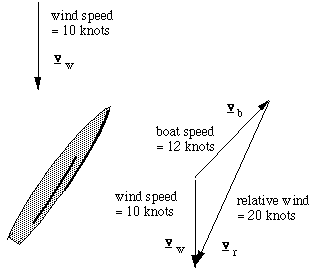This question came out when we discussed about the force required to move the sailboat. The more the air trapped, the faster the sailboat moves. So, one of the students was arguing on how the more air will make it moves faster? He thought that the more the air, the more the air resistance produced in opposite direction, thus slows down the sailboat. Hm.. actually, I can not answer that question on the spot. So, I searched for them, so that they can refer at least. ...
How can boats sail faster than the wind? Lots of boats can---especially the eighteen footer skiffs on Sydney Harbour. Ask a sailor how, and he'll say "These boats are so fast that they make their own wind", which is actually true. Ask a physicist, and she'll say that it's just a question of vectors and relative velocities.
Downwind (diagram at left) is easy. If the wind is 10 kt, and the boat makes 6 kt in the same direction, then the crew feels a wind of 4 kt coming over the stern of the boat. The true wind vw equals the speed of the boat vb plus the relative wind vr (see vectors for more explanation). The equation vw = vb + vr tells us the problem: as the boat speed approaches the wind speed, the relative wind drops towards zero and so there is no force on the sail. So you can't go faster than the wind. When the wind is at an angle, we have to add the arrows representing these velocities (vector addition). Upwind (right), exactly the same equation holds: vw = vb + vr.
The faster that the boat goes, the greater the relative wind, the more force there is on the sails, so the greater the force dragging the boat forwards. So the boat accelerates until the drag from the water balances the forward component of the force from the sails.



No comments:
Post a Comment
Leave your comment here